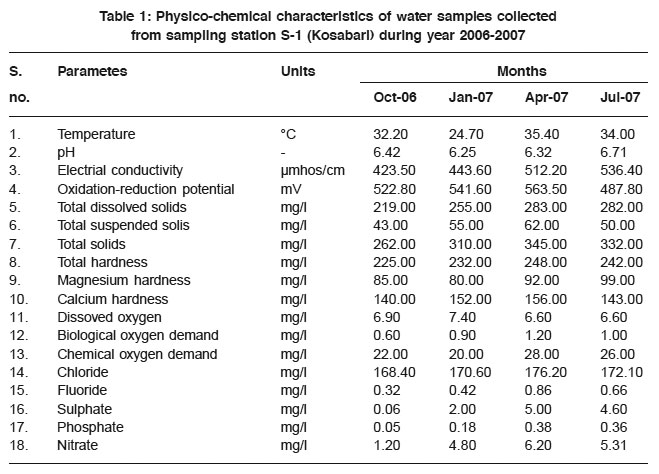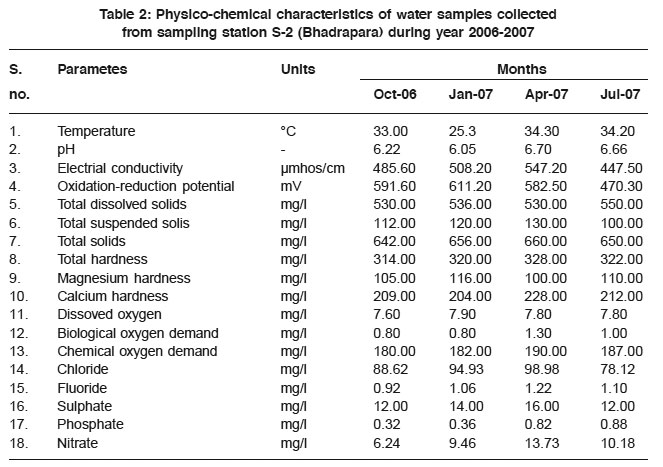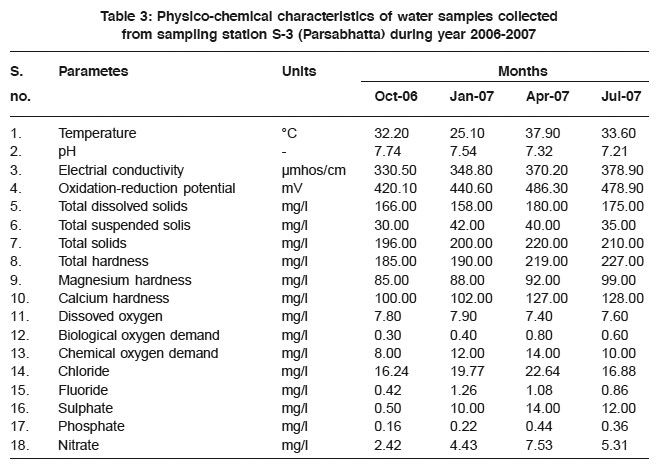Studies on the physico-chemical characteristics of ground water of Korba
Renu Nayar1 * and Deepak Tiwari1
1
Department of Chemistry,
D.P. Vipra College,
Bilaspur,
India
DOI: http://dx.doi.org/10.12944/CWE.3.1.27
The paper reports analysis of physico-chemical characteristics of underground drinking water of industrial areas of Korba in Chattisgarh state. This study analysed quarterly physico-chemical data collected from four sampling stations in Korba and its surrounding industrial areas from January 2006 to December 2007. The results of this analysis reveals that electrical conductivity of water samples was found to be as high as 547.20 µmho/cm during April 2007 at Bhadrapara. The maximum value of the total dissolved solids and total solids recorded was 550 mg/l in July 2007 and 660 mg/l in April 2007 at Bhadrapara which is higher than permissible limit of WHO standards (>500mg/l). The value of COD and total hardness of the various sample were always higher than the permissible limits. COD of the water samples recorded a maximum of 190mg/l at Bhadrapara during April 2007. High values of fluoride (>1mg/l) and nitrate (>10mg/l) concentration were recorded at some stations. All the samples had chloride concentration within the permissible limit ranging from 16.24mg/l at Parsabhatta in October 2006 to 176.2 mg/l at Kosabari in April 2007. It is found that all water samples are free phosphate pollution as the amount of phosphate varied from 0.05mg/l at Kosabari in October 2006 to 0.88mg/l at Bhadrapara in July 2007 during the entire study perio
Copy the following to cite this article:
Nayar R, Tiwari D. Studies on the physico-chemical characteristics of ground water of Korba. Curr World Environ 2008;3(1):175-180 DOI:http://dx.doi.org/10.12944/CWE.3.1.27
Copy the following to cite this URL:
Nayar R, Tiwari D. Studies on the physico-chemical characteristics of ground water of Korba. Curr World Environ 2008;3(1):175-180. Available from: http://www.cwejournal.org/?p=799
Download article (pdf)
Citation Manager
Publish History
Select type of program for download
| Endnote EndNote format (Mac & Win) | |
| Reference Manager Ris format (Win only) | |
| Procite Ris format (Win only) | |
| Medlars Format | |
| RefWorks Format RefWorks format (Mac & Win) | |
| BibTex Format BibTex format (Mac & Win) |
Article Publishing History
| Received: | 2008-03-17 |
|---|---|
| Accepted: | 2008-05-28 |
Introduction
The crucial role ground water plays as a decentralized source of drinking water for millions of rural and urban families can not be overstated. According to some estimates, it accounts for nearly 80% of the rural domestic water needs, and 50% of the urban water needs in India. Ground water is generally less suspectable to contamination and pollution when compared to surface water bodies. But in India, where ground water is used intensively for irrigation for agricultural purposes, a variety of land and water based human activities are causing pollution of this precious resource. A part from its depletion due to excessive use, the quality has degraded due to the transport of various organic and inorganic pollutants to the ground water. Continuous monitoring of water quality is necessary to understand the level and nature of such contamination. The survey of literature shows that various workers have investigated the status of ground water in India. Sujatha. D and Rajeshwara Reddy, B. (2003) have carried out hydrogeochemical investigation in the south-eastern part of Ranga Reddy district, Hyderabad to assess the quality of ground water for its suitability for domestic and irrigation purpose. The results showed that the concentration of NO3-, Cl- and F- are above the permissible limits for drinking and irrigation purpose. The pollution with respect of NO3-, Cl- and F- was mainly attributed to the extensive use of fertilizers and large-scale discharge of municipal wastes into the open drainage system of the area.
Sastry, K.V. et al., have carried out the analysis of pollution potential of the industrial effluents and sludge. Studies on their influence on ground water revealed the presence of chromium and cyanide in ground water of polluted are above the permissible limits for drinking water standards.High BOD level had been observed in all the ground water samples from polluted area. It is interesting to note that the level of nickel in water samples from polluted area was very low, although high concentration has been observed in effluents and sludge. Manjappa, S., et al., (2003) have investigated the quality of ground water supplies in Devanagre taluk, situated in central part of Karnataka with respect to pH, dissolved solids, chlorides, nitrates and fluorides. The levels of pH, dissolved solids and chlorides were found within the safe limits as prescribed by BIS, for more than 95% of the samples. Out of 61 different samples analyses selected from different areas of Devanagre taluk, 26% of the samples were found to contain fluorides less than 0.50ppm (lower safe limit prescribed by BIS) and 11.5% of the samples were found to contain more than 1.5 ppm of fluorides (higher safe limit prescribed by BIS). Further, it was also found during study that, 16.00% of the bore well samples analyzed, were found to contain more than 100.00ppm of nitrates (measured as NO mg/l, safe limit prescribed by BIS). The value of fluorides and nitrates observed in different samples were in the range of 0.19-2.06ppm and 0.08-308ppm, respectively. Meenakshi et al., (2004) have determined the fluoride concentration in underground water in four villages of Jind district of Haryana state (India) where it is the only source of drinking water. The fluoride concentration in the underground water of these villages varied from 0.3 to 6.9mg/l, causing dental fluorosis among people especially children of these villages, Tyagi, P. et al., (2000) have reviewed with many references, of available work on the physico-chemical quality of ground water in industrial areas (Zinc smelter plants, ore-mining industries, steel plants, thermal power plants, tanneries, distilleries and heterogeneous group of industries) in India. Due to improper drainage system, mixing with running water pipelines, septic tanks and solid waste disposal, contamination of ground water by organic chemicals and microorganisms occurred. Similarly, contamination due to inorganic chemicals is mostly from seepage of effluents from industries. The concentrations of some parameters (color, hardness, COD, BOD, fluoride, chloride, sulphate, calcium, nitrate, phenols etc.) in the industrial area were much higher than the permissible limits of WHO (1993) and ISI (1991) drinking water standards. The objective of the present investigation is to investigate the underground water (hand pump) in Korba and its surrounding industrial areas.
Material and Methods
Korba is an important industrial city of the newly formed state of Chhattisgarh. The city is located at 20° 13' latitude and 82° 35' longitude. It is situated on the left bank of Hoadeo river. Korba city and its surrounding industrial area has the credit of having Starlite Aluminum Company Ltd. (formerly Bharate Aluminum Company Ltd.); hydel power plant on the Bango dam, BALCO captive power plant (BCPP); Korba Super Thermal Power Station (NTPC); Korba Thermal Power station CSEB Korba (East); Hasdeo Thermal Power Project CSEB (West) and the various coal mines of South Eastern Coal Limited such as Dipika, Gevera, Laxman, Kusmunda etc. The fast pace of industrial and other developmental activities and the consequent rapid growth have, however invariably brought with them unplanned and haphazard humand settlements and problem of water supply, sanitation and environmental degradation in the form of air water and noise pollution. Although the Hasdeo river caters the water requirements of a majority of the population, still a significant population residing in the suburbs are using underground (hand pump water) water for bathing, drinking and other domestic) purposes. Hence it was strongly felt that the water quality assessment of these hand pumps situated in different areas is very much essential. The following sampling sites in Korba city and its surrounding industrial areas were selected for assessing their water quality: Kosabari (Residential location) S-1, Bhadrapara S-2, Parsabhatta S-3 and Rungarha S-4. Water samples were collected from four hand pumps located in residential and industrial are in Korba with necessary precautions. From these hand pumps water samples have been collected from October 2006 to July 2007 every three months in precleaned polythene bottles of good quality of one liter capacity.
 |
Table 1: Physico-chemical characteristics of water samples collected from sampling station S-1 (Kosabari) during year 2006-2007 Click here to view table |
The analysis of the following physico-chemical parameters was carried out: pH, temperature, electrical conductivity, oxidation-reduction potential (ORP), total hardness, calcium hardness, magnesium hardness, total solids, total dissolved solids, total suspended solids, dissolved oxygen (DO), biochemical oxygen demand (BOD), chemical oxygen demand (COD), fluoride, chloride, phosphate and nitrate.
 |
Table 2: Physico-chemical characteristics of water samples collected from sampling station S-2 (Bhadrapara) during year 2006-2007 Click here to view table |
Parameters such as pH, temperature, conductivity, oxidation-reduction potential, dissolved oxygen were measured at the sample collection site using a portable kit (water quality analyses). Determination of other parameters such as hardness, total dissolved solids, total suspended solids, total suspended solids, DO, BOD, COD, sulphate, phosphate, nitrate, chloride and fluoride were carried out by standard methods as prescribed by APHA (1989), Manivaskam (2000), Trivedi and Goel (1986) and NEERI manual on water and waste water analysis. Reagents used for the present investigation were of A.R. grade and double distilled water was used for preparing various solutions.
 |
Table 3: Physico-chemical characteristics of water samples collected from sampling station S-3 (Parsabhatta) during year 2006-2007 Click here to view table |
Results and Discussion
The physico-chemical data of ground water samples collected from different sampling stations during October 2006 to July 2007 are presented in Tables 1 to 4. The value of pH value of water from handpumps at S-1, S-2 and S-4 indicates that all these samples were acidic, while water sample at S-3 was alkaline. Maximum value of electrical conductivity observed was 54720 µmho/cm in April 2007 at S-2 which was above the maximum permissible limit of 500µmho/cm, in drinking waters as recommended by WHO. High values of electrical conductivity are due to high concentrations of ionic constituents present in the water body. The importance of EC is its measure of salinity, which greatly affects the taste and thus has significant impact on its uses. There was not a single occurrence of the value of electrical above RMPL (WHO) at S-3 and S-4 for the entire study period. The value of total dissolved solids at S-2 was always above the maximum permissible limit of WHO (500mg/l) reaching a maximum value of 550mg/l during July 2007. The total dissolved solids (TDS) in all other samples values were always above the WHO permissible limit of 200mg/l at S-1 and S-2. It can be concluded that water is hard at these locations, which necessitates the softening of water prior to its use. Calcium hardness was recorded much above the value of 75mg/l recommended by the Indian standards at all the stations during the entire study period. Dissolved oxygen was recorded in the range 6.60mg/l at S-1 in July 2007 to 8.10mg/ l at S-4 in January 2007. Maximum permissible limit for dissolved oxygen as per WHO and USPHS is 4.6-6.0 mg/l. Dissolved oxygen was within the admissible limit in all the water samples. The main source of dissolved oxygen, which is turn is influenced by water temperature, water movements and salinity. WHO has recommended 6.0 mg/l as the maximum permissible value for biological oxygen demand (BOD), but the BOD values found never exceeded this limit at all the sampling stations indicating no biological pollution load on these water bodies. During the study period, the chemical oxygen demand value observed at S-2 (Bhadrapara) were many times higher than the maximum permissible limit of 10mg/l prescribed by WHO at during the entire study period. The maximum value of COD observed was 190 mg/l at S-2 in April 2007. In the present study the COD value were always higher than the BOD values. This result clearly indicated that the underground water samples contain more of non-biodegradable chemical pollutants. This mainly due to the entry of municipal sewage, various industrial effluent and agricultural waste into the environment. During the present investigation, it was observed that the chloride concentration in all the samples collected from different sampling stations during the study period was below the recommended concentration of 250mg/l. The maximum concentration of chloride was observed at 176.20 mg/l at S-1 in April 2007, whereas the minimum concentration of chloride was 16.24mg/l at S-3 in October 2006. During the present investigation maximum fluoride was recorded to be 1.22mg/l in the month of April 2007 at station S-2. This is higher than the permissible limit recommended by Indian standards. Perusal of the various tables also shows that the fluoride concentration in water samples at S-2 and S-3 is comparatively higher than that at S-1 and S-4. Fluroride is naturally occurring toxic mineral present in drinking water, and has significance from physiological point. It has a considerable impact on human physiology causing a disease, called fluorosis.
 |
Table 4: Physico-chemical characteristics of water samples collected from sampling station S-4 (Rungarha) during year 2006-2007 Click here to view table |
Dental fluorosis is present in the areas where the fluoride content of drinking water exceeds 1 mg/l, while crippling skeletal fluorosis is present whenit exceeds 5 mg/l. The sulphate concentration in all the water samples analyzed during the entire study period remained below 150mg/l, the maximum allowable limit of sulphate in drinking water according to Indian standards. USPHS has recommended a maximum permissible limit of 0.1 mg/l total phosphate in drinking water. During the entire study period and at all the sampling stations, phosphate was found to be largely above the recommended limit, reaching a maximum value of 0.88 mg/l at S-2 in the month of July 2007. The quality criteria for phosphorus in water are only to check nuisance growth of algae and process of entrophication.
Nitrate enters the human body through the use of ground water for drinking and causes a number of health disorders, namely methemoglobinemia, gastric cancer, goiter, birth malformations. hypertension etc., when present in high concentration in drinking water. USPHS has proposed that the nitrate level in drinking water should be limited to 10mg/l for drinking purpose. Nitrate level in the water samples collected from sampling station S-4 during the study period remained largely above the permissible limit. Nitrate concentration was recorded highest in April 2007 at S-4 with its value as high as 17.72 mg/l.
Conclusion
The present study has been made to evaluate the quality of underground water of Korba city and its surrounding industrial areas. of four representative underground (handpumps) water samples were collected from different locations of Korba city and its surrounding industrial areas. Sampling was done every third month over a period of 2006-2007. These samples were analysed for 18. physico-chemical parameters to evaluate their suitability for domestic applications. Water samples varied greatly in quality with respect to different physical-chemical constituents. The present study clearly reveals that the chemical parameters like, EC, TDS, BOD, COD, F-, PO4 and SO4- at S-2 (Bhadrapara, a site near the BALCO) are in excess when compared with other sampling stations. In many samples at S-2 the value of these parameters are higher than the permissible limits of WHO and ISI. Thus to maintain the quality of ground water, preventive measures have to be taken to control the above parameters within the permissible limits.
References
1. APHA. Standards method for examination of water and waste water Americal Public Health Association, Washington. D.C. (1989)
2. Manivaskam, N., Physico-chemical examination of water, sewage and industrial effluents. Pragati Prakashan, Meerut (2000).
3. Manjappa, S., Basavaragappa, B.E., Desai, G.P., Hotanahalli, S.S. and Arvinda, H.B., Nitrate and fluoride levels in ground water of Devanagere Taluka in Karmataka., Indian J. Environ. Him., (2003) 45(1): 155-160.
4. Manual on water and waste water analysis. NEERI. Publication (1988).
5. Meenakshi, Garg, V.K., Kavita, Renuka and Malik, A., Ground water quality in some villages of Haryana India, focus on fluoride and fluoresis, Journal of Hazardous Materals., (2004) 106(1): 85-97.
6. Sujatha, D. and Rajeshwara Reddy, B., Quality characterization of ground water in the south-eastern part of the Ranga Reddy district, Andhra Pradesh. Indian Environ. Geo. (2003) 44(5): 579-586.
7. Trivedi, R.K. and Goel, P.K., Chemical and biological methods for water pollution studies. Envrion. Pub. Karad. Indian, (1986) 1-28
8. Tyagi, P., et al., Physico-chemical quality of ground water in industrial areas of India. A review. Poll. Res. 19(3): 443-455 (2000)






